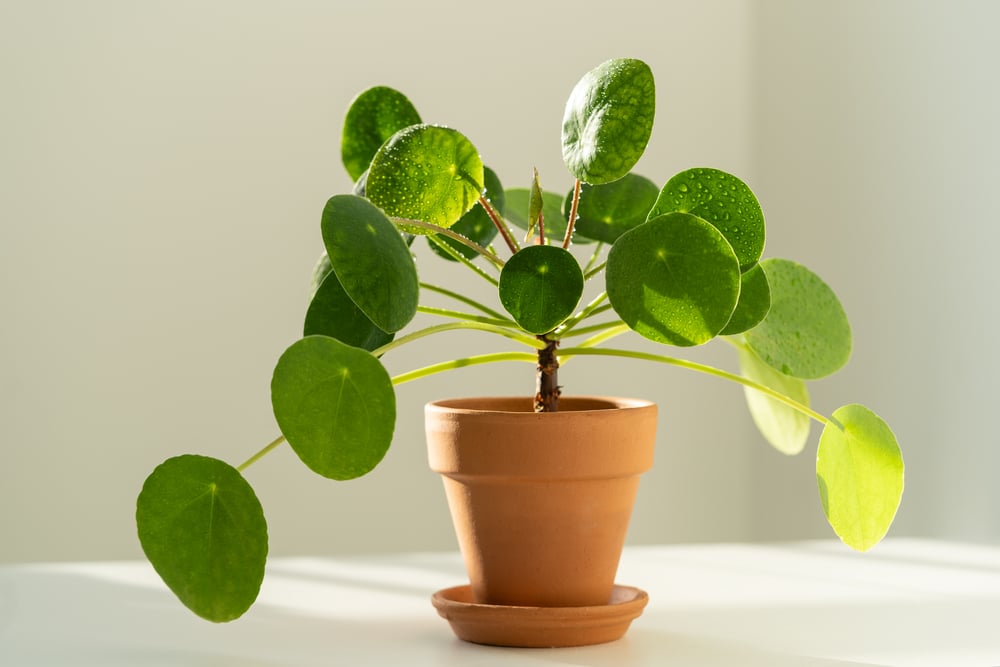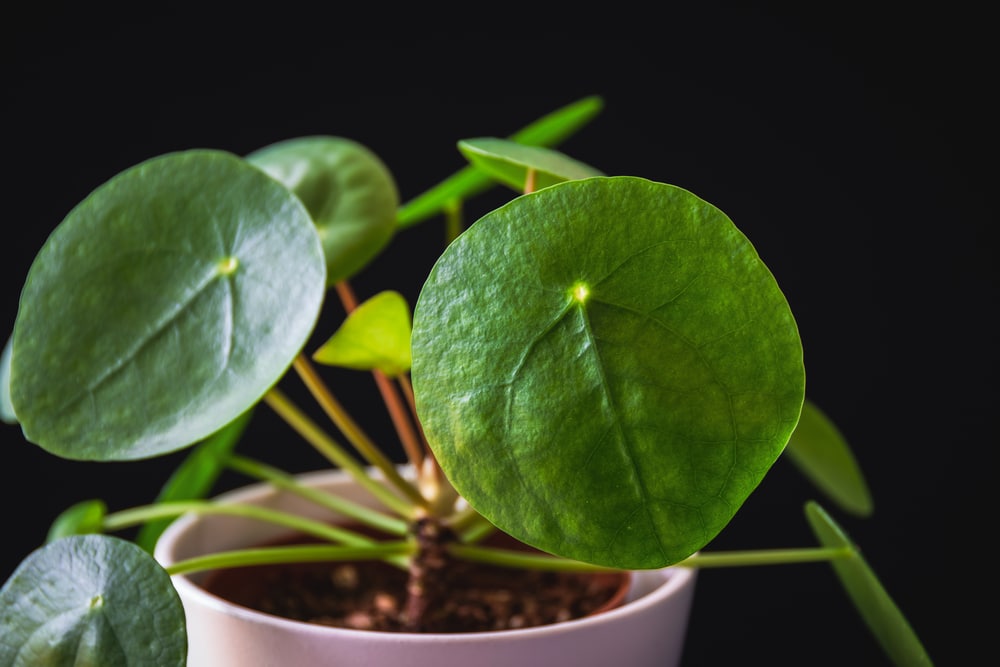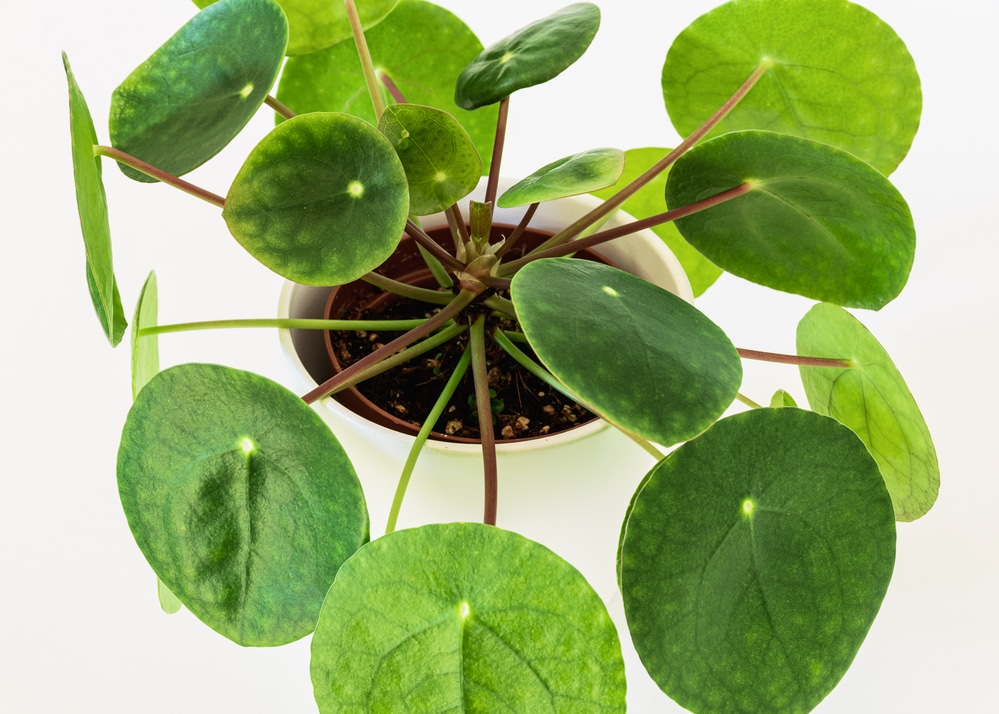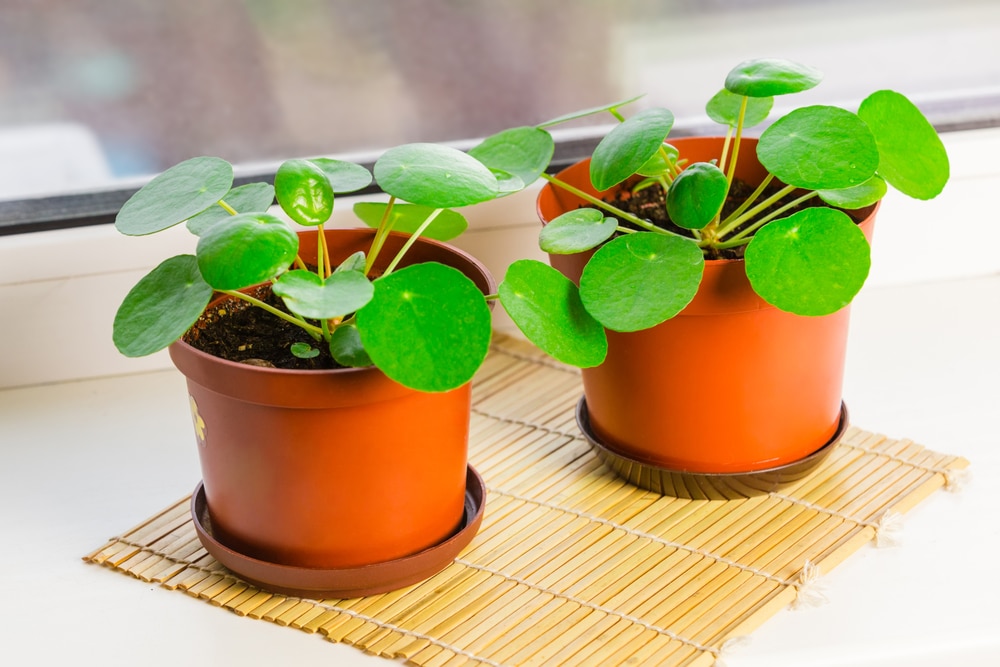With its saucer-shaped leaves and unique growth habit, the charming Chinese money plant may not bring you all the monetary riches, but it will light up your home. Chinese money plants (Pilea peperomioides) are fuss-free houseplants, popular worldwide. They are excellent beginner houseplants because they clearly tell you what they need; there’s no subtlety with this one!
Pilea Peperomioides Origin & History
Pilea peperomioides has several common names, including the UFO plant, pancake plant, friendship plant, missionary plant, and the most common, Chinese money plant. P. peperomioides is native to southern China and was first collected by the Scottish botanist George Forrest in 1906. It wasn’t commercially cultivated until the late 2010s, though, because few people knew about it, even though it had been around for a long time.
In 1945, the Norweigan missionary Agnar Espegren brought a cutting back to Norway, and it became popular in Scandinavia. However, it stayed a plant for amateur gardeners until the 1980s, when an image of it was published. Previous to that, western botanists didn’t know it well or at all. Now, Pilea peperomioides is one of the most popular houseplants around the world. Sadly, in the wild, it is quite rare and likely endangered.
The disk or coin-shaped deep-green foliage is strikingly unique. It isn’t surprising it is known as the UFO plant since the foliage looks like a bunch of saucers flying around the center stem. This houseplant grows in various ways, which is just one of the reasons for its jump in popularity.
Depending on the conditions, it will grow densely from the central point, with the circular foliage facing outwards in all directions. It is also known to grow tall and spindly, with foliage only at the top, like a tree from a Dr. Seuss book.
The rounded glossy leaves grow up to 4” in diameter at the end of long, thin stems. The stem attaches to the leaf underside near the center, and each stem produces one leaf. Chinese money plant stems are dark brown or green, upright, and they don’t branch. It usually grows to around 12” tall and wide, but in optimal indoor conditions, it can get bigger.

Chinese Money Plant Care Guide
This section cover important care topics such as watering, lighting requirements, fertilization, re-potting and more.
Growth Habit
P. peperomioides growth is governed by light. It will grow bushy and dense with foliage stretched out widely around the central stem if it is in a location with consistent bright, indirect light. It should be rotated regularly so the growth remains even and doesn’t become one-sided or angled.
A Chinese money plant that isn’t receiving enough light will stretch out in wild and wonderful ways to reach it. But, they will only grow foliage at the top portion of the stem. So, as the stem reaches out to the light, the money plant drops its lower leaves and continues growing denser leaf groupings at the top. Plants have been known to grow 4-5 feet tall, like a tree with an ultra-narrow stem and minimal foliage.
This isn’t how the plants are “meant” to grow, but it is still a fascinating look if you want to experiment. The lower part of the stem will not regrow foliage; it will remain bare, creating a top-heavy situation. These P. peperomioides need support, as the stems aren’t strong enough to hold the plant up.
The most significant growth issue folks experience is thin foliage, which creates unattractive gaps in the overall look. This is rectified with adequate indirect light and regular rotation for even growing.
Lighting
A spot near an east or west-facing window with significant bright indirect light is ideal. Direct sunlight will burn the leaves, so keep the Chinese money plant at least a foot away from the window. Or, use blinds or a curtain to block the strongest rays.
On the opposite end, too little light causes faded colors and slow growth. Don’t put it in a shady or low-light area, as it will struggle, and the leaves will droop and possibly die.
Think of the circular foliage as satellites aimed towards the sun to take in the most energy. Just keep it indirect, and you’ll have a happy pancake plant. This plant wants to be rotated every other week or so to keep the growth even on all sides.
Watering
P. peperomioides likes deep, thorough watering on a regular basis – usually every 1-2 weeks. It doesn’t want to dry out completely and doesn’t like overly soggy soil, either. The best way to determine if your plant needs water is to stick your finger in the dirt and check the dryness.
If the top 2-3 inches of soil is still moist, wait a few more days before watering. When the top 2-3 inches of soil are dry, water slowly and thoroughly. Allow the soil to absorb the water until it drains out the bottom. Be sure to empty the saucer underneath the planter, so the roots don’t sit in standing water.
Temperature & Humidity
Average indoor temperatures between 60-75 degrees are fine for the Pilea peperomioides. It doesn’t have high humidity demands and will be fine in average household humidity. If you notice the leaf edges are getting crispy, it usually means it wants some more humidity, but this rarely happens.
Keep this houseplant away from heat vents and registers, air conditioners, and drafts, as extreme temperature fluctuations may cause it to drop leaves.
Soil & Potting
Use high-quality organic potting soil mixed with some perlite and coco coir to improve drainage and moisture retention.
The container shouldn’t be overly large since the roots aren’t that robust. Make sure it has drainage holes so that the soil doesn’t get soggy, leading to root rot.
Fertilizer
Add a high-quality organic house fertilizer once a month during the growing season. Hold off during the winter when the plant is resting.
Pruning
Pruning is rarely needed except to remove damaged or dead leaves.
Repotting
Every year or year and a half, plan on repotting your Chinese money plant to refresh the soil and nutrients. If you want your plant to grow bigger, repot it to a container that is just 1-2” wider in diameter. Don’t use a much larger pot as this causes watering issues. Repot it to the same container if you want it to keep the same size.
Toxicity
Pilea peperomioides are non-toxic for people and pets.

Chinese Money Plant Propagation
P. peperomioides spread naturally throughout the houseplant world for decades because it is super easy to propagate. That’s how it earned the name friendship plant, or “pass it on plant” – you could always get a cutting or pup from a friend, and probably a lot more than one if you wanted. P. peperomioides is the plant gift that keeps on giving.
Stem Cutting Propagation
- A healthy, mature Pilea peperomioides produces pups or babies from the main stem. You’ll see these little pups grow up around your mama plant, and multiple babies can grow simultaneously.
- Wait until the pups are at least 2-3″ tall to ensure they’re strong and robust.
- Spring is the best time for propagation since it’s when the mother plant is strongest.
- Gently dig in the soil around the baby plant to find the roots and expose the connection.
- Using a pair of sharp, sterilized shears, cut the stem away from the mother.
- Plant it directly in soil, or let it root further in water. Either option works fine.
- Place in a warm environment with lots of bright, indirect light.
- The plant pup may droop or drop leaves for a little bit from the stress, but it will bounce back. This may take up to a month, though.
When the little plantlet pups appear, you don’t have to remove them all. If there is enough space in your potting container, you can leave one or two to grow alongside the mama plant. This is one way to achieve a denser-looking foliage display because the leaves will overlap.
However, if you leave every pup that appears, you’re likely to get a very unruly plant with foliage shooting off in every direction. It’s up to you, though. Moving the mama to a larger container with the pups is also an option to give them all the necessary space to grow.

Pests and Disease
Pilea peperomioides rarely suffer from pests or disease; it is a hardy houseplant. However, it can still be affected by common houseplant issues. To keep your Pilea happy and healthy, inspect the foliage and soil regularly to ensure there aren’t any issues. Checking the plant’s stems, leaves (top and bottom), and dirt every time you water is a great way to catch any issues before they become big problems.
Thrips, Spider Mites, Mealybugs, and Aphids
Tiny houseplant pests that eat leaves and suck out the plant’s juices from the stem are a common problem. These insects are small and difficult to see. But, you’ll see their presence through brown spots on leaves, yellowing edges, and slow or stopped growth.
Move the plant away from your other houseplants if you notice any issues. Pests and diseases love to jump from one plant to another, causing even more significant problems.
The best method for dealing with these bugs is a neem oil spray. Repeat the treatment every 5-7 days until the pests are gone. Combine two teaspoons of neem oil with one teaspoon of dish soap in a quart spray bottle. Fill up the bottle with water and shake it well. Spray the plants lightly, coating the leaf undersides and soil as well, since that’s where the bugs like to hang out and lay eggs.
Common Questions
Here are some of the most common questions about Chinese Money Plant care:
Why are the leaves of my Chinese money plant drooping?
This is your money plant speaking to you; it needs water or light. Check the soil to see if it’s dry. If it is, water slowly and thoroughly, making sure the soil absorbs the water well. Also, ensure that P. peperomioides is getting enough bright, indirect light.
Why is the foliage on my Chinese money plant curling?
Healthy foliage is round and mostly flat. If the leaves are curling inwards or outwards, it’s a sign your plant is stressed out. This is another situation in which your Pilea is telling you what it does and does not need. The leaves hold water, and so when the water content is off, the leaves will react.
Curling leaves are usually caused by under or overwatering. If the leaves are curled downward, it indicates overwatering – the leaves are attempting to expand to hold the extra water.
Foliage that is curled upward is due to underwatering. The peperomioides is trying to reduce the leaf surface to limit water loss. For foliage with both types of curling, inconsistent watering is the culprit. Scarcity followed by abundance leaves the plant confused and causes all sorts of foliage deformities.
What is causing the lower foliage of my P. peperomioides to turn yellow and fall off?
It is likely the plant is being overwatered. Double-check the soil before watering and only water when the top 2-3 inches are dry. The foliage holds a bit of water, so overwatering can occur easily if you’re not paying attention.
Why are there white spots under the leaves of my P. peperomioides?
Don’t worry; these white spots are actually pores, called stomata. They play a critical role in photosynthesis and are entirely normal.
What is causing brown spots on the foliage of my Chinese money plant?
Brown spots are usually a symptom of overwatering. If the soil isn’t allowed to dry out, the spots will grow bigger, and the leaves will fall off. Always check the soil before watering to ensure it’s not getting too much.
Why are the leaves of my Pilea so spread out?
Thin foliage is typical with young plants; it takes a bit of time to bush out and become overlapping. If it is still small and young, give it some time and ensure it gets lots of indirect light.
Mature plants that still have thin foliage aren’t receiving enough indirect sunlight. Move it to a location with more light (but not direct light).
This captivating houseplant, with its coin-shaped foliage and easy-going nature, will elevate any space it occupies. And, it’s a great way to make new friends. Once those pups start appearing, you’ll have a whole brood of peperomioides to give away. Riches aren’t gold or silver; they’re also green and pancake-shaped.

